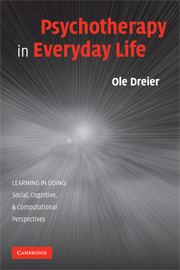Book contents
- Frontmatter
- Contents
- Series Foreword
- Preface
- Introduction
- 1 Re-Searching Psychotherapy as a Social Practice
- 2 Theorizing Persons in Structures of Social Practice
- 3 A Study – Its Design and Conduct
- 4 Clients' Ordinary Lives Plus Sessions
- 5 Therapy in Clients' Social Practice across Places
- 6 Changes in Clients' Practice across Places
- 7 Changing Problems across Places
- 8 The Conduct of Everyday Life and the Life Trajectory
- 9 The Children's Changing Conducts of Everyday Life and Life Trajectories
- 10 The Parents' Changing Conducts of Everyday Life and Life Trajectories
- 11 The Changing Conduct of Everyday Family Life and Family Trajectory
- 12 Research in Social Practice
- References
- Author Index
- Subject Index
- Learning in Doing: Social, Cognitive, and Computational Perspectives
11 - The Changing Conduct of Everyday Family Life and Family Trajectory
Published online by Cambridge University Press: 15 December 2009
- Frontmatter
- Contents
- Series Foreword
- Preface
- Introduction
- 1 Re-Searching Psychotherapy as a Social Practice
- 2 Theorizing Persons in Structures of Social Practice
- 3 A Study – Its Design and Conduct
- 4 Clients' Ordinary Lives Plus Sessions
- 5 Therapy in Clients' Social Practice across Places
- 6 Changes in Clients' Practice across Places
- 7 Changing Problems across Places
- 8 The Conduct of Everyday Life and the Life Trajectory
- 9 The Children's Changing Conducts of Everyday Life and Life Trajectories
- 10 The Parents' Changing Conducts of Everyday Life and Life Trajectories
- 11 The Changing Conduct of Everyday Family Life and Family Trajectory
- 12 Research in Social Practice
- References
- Author Index
- Subject Index
- Learning in Doing: Social, Cognitive, and Computational Perspectives
Summary
In this chapter I shall go into family life by taking up the conduct of everyday family life and the family trajectory. Families are involved in different sociocultural forms of life (Christensen 1987) with different conducts and understandings of family life. Other cases than the one I analyze would therefore show other links and patterns in the conduct of everyday family life and family trajectory. This family also withdrew into a particularly isolated family life and moves beyond it hesitatingly. The parent's relation to work is quite instrumental, and education is not so important for the daughters. This restricts what my materials cover.
In social theory, the family is seen as a social institution in a social structure. This institution predates and frames the formation of individual families and is pre-given in the material–practical sense of family homes as places arranged for family practices. A particular ordering is thus created as “an arrangement of people in which they perform interlocking actions, are entangled in particular relations, and pursue specific identities” (Schatzki 1996, 5). Besides, the institution of the family plays a particular role in individual life trajectories. It is a changing, long-term part of individual lives, and a break and replacement of family membership is built into the social arrangement for life trajectories in that children are born into a family of origin, which they leave when they grow up to create a new family at a later time.
- Type
- Chapter
- Information
- Psychotherapy in Everyday Life , pp. 255 - 286Publisher: Cambridge University PressPrint publication year: 2007



